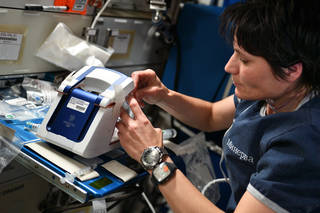As NASA plans to send to astronauts farther into space and for longer durations, managing and maintaining astronauts’ health has become more important than ever. In a recent technology demonstration mission, experts from NASA’s Human Research Program’s Exploration Medical Capability (ExMC) team tested the Reusable Handheld Electrolyte and Laboratory Technology for Humans (rHEALTH) ONE biomedical analyzer, a portable device that uses laser technology to diagnose illness or injury.
Launched to the International Space Station (ISS) in February, rHEALTH is a miniature flow cytometer that detects cells and other biomarkers to assess biological changes. It was put through a series of tests on the space station over two days by Samantha Cristoforetti of ESA (European Space Agency). The ExMC research group, which is working to provide medical tools and capabilities for astronauts to use in exploration spaceflight, adapted the rHEALTH analyzer for use in microgravity.

ESA astronaut Samantha Cristoforetti operates the rHEALTH analyzer on the International Space Station in May 2022. Courtesy of NASA.
There are a variety of medical conditions that can affect astronauts who live for prolonged periods in space, including blood clots, kidney stones, radiation exposure, and a range of other illnesses and injuries. But access to traditional medical diagnostics and treatments when working on the moon or even Mars would not be available.
“Astronauts could use rHEALTH to perform a full self-diagnosis without technical training,” said Eugene Chan, inventor of the unit. “They only need a drop of blood, saliva, or urine to put into the reader and within minutes they have the results of a range of crucial health indicators.”
The device offers a two-pronged approach. A sensor affixed to the chest streams real-time vital signs to the astronauts and to NASA’s medical team on Earth. Additionally, the astronaut collects a single biological sample (e.g., blood, saliva, etc.) on a nanostrip and inserts it into the device.
Inside the rHEALTH reader, microfluidic technology performs dilution, mixing, and complete sample prep.
The sample is then exposed to two lasers that read and analyze it, collecting over 100 million raw data points for particles the size of cells. Thousands of tests are recorded, referenced to calibrators, and communicated to the astronaut and to physicians on the ground, within minutes. This type of demo using small samples is the first of its kind in orbit, allowing astronauts the potential to get much more biomedical information, and faster, according to NASA.
Prior to its launch to the station, the rHEALTH analyzer was modified to function in microgravity. On Earth, gravity pulls water to the bottom of containers and air rises to the top. But in space, the two float freely together. Engineers adapted all the external connections to seal in the water and create air/water separation techniques to keep air bubbles out. The team developed a container that could be squeezed easily and made an assembly with soft medical balloons that resembles a pair of lungs. The rHEALTH unit uses that to push water with air pressure to flow a sample through the device.
The ExMC’s mission includes advancing medical system design for exploration beyond low Earth orbit and promoting human health and performance in space in collaboration with other scientists. These scientists evaluate various commercially available medical technologies developed on the ground to test them aboard ISS for potential use in future space exploration.